https://www.ammoland.com/wp-content/uploads/2025/07/223-556-ammo-ammunition-Cartridges-pile-bulk-ammo-iStock-johnaudrey-527840839-500×255.jpg
Opinion
The ammo market can be tough. Prices for .223 and 5.56 NATO have calmed down since the wild days of 2020–2022, but finding cheap ammo still feels like a treasure hunt.
The One Big Beautiful Bill Act (OBBB), or H.R.1 from the 119th Congress, is a much-discussed and huge new funding bill signed into law by President Trump that’s getting attention for its defense spending.
But there’s a part no one’s talking about: it could flood the market with small arms ammo and keep prices low.
The OBBB is too new to change prices yet, but it could kick-start a golden age for ammo. Let’s break down the key parts, quote the bill, and see how they might make ammo cheaper and easier to get.
Gun owners hoped the Hearing Protection Act would make suppressors easier to own and the SHORT Act would simplify short-barreled rifle rules, but those didn’t pass. Instead, the OBBB delivered a $0.00 tax stamp fee for suppressors, and short-barreled rifles, removing the $200 ATF tax—a big win for Second Amendment fans.
Still, the real game-changer might be the ammo provisions, which could make range days cheaper and easier by boosting ammunition manufacturing and supply.

The OBBB’s Ammo-Boosting Parts
The OBBB’s Ammo-Boosting Parts
The OBBB funding, found in the bill, covers tons of stuff, from defense to roads. In Title III (Department of Defense Appropriations Act, 2026), four parts could ramp up small arms ammo production—like 5.56mm, 7.62mm, and .50 BMG—and send more to gun stores. Here’s what they are, what they do, and why they matter.
1. $100 Million for Small & Medium Ammo
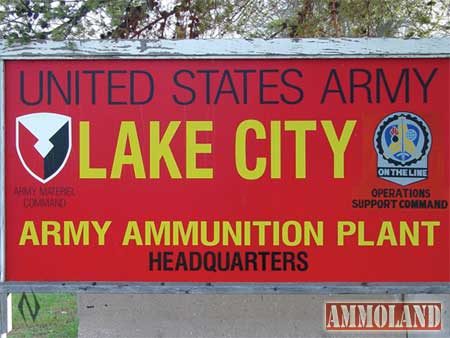
“(39) $100,000,000 for the production of small and medium ammunition;” (page 111 of the pdf.)
What It Means: This part gives $100 million to make more “small and medium ammunition,” like .223 Remington and 5.56 NATO. Places like Lake City Army Ammunition Plant in Missouri, the biggest maker of small arms ammo for the U.S. military, will likely get some of this cash. Lake City makes 1.4–1.6 billion rounds a year, with half sold to civilians, covering ~30% of the 5.56mm market. This $100 million could add 200–333 million rounds a year, with 50–100 million going to stores.
*NOTE: while “small and medium ammunition” likely includes 5.56x45mm NATO and .223 Remington, the exact calibers are not specified in the OBBB, and some funds could support related components (e.g., propellant powder) or other facilities. Funding Uncertainties: The $100 million’s allocation to specific facilities like Lake City is assumed but not confirmed, as funds could partially go to other sites like St. Marks Powder for propellant production.
Why It Matters: More ammo means more supply, which can stop price spikes when everyone’s buying. The OBBB doesn’t limit Lake City’s commercial sales, so brands like Federal, Winchester, and Hornady (which sell Lake City ammo) could have more stock. This is a quick boost, so shelves might see more rounds by late 2025 or 2026.
2. $1 Billion for High-Tech Ammo Factories
“(35) $1,000,000,000 for the creation of next-generation automated munitions production factories;” (page 111 of the pdf.)
What It Means: This drops $1 billion to build new, high-tech ammo factories with robots and smart tech. “Munitions” is a broad word, but it likely includes small arms ammo since the bill focuses on military needs. These factories could upgrade Lake City or start new plants, making more rounds.
Why It Matters: High-tech factories can produce ammo faster and cheaper. If they make 5.56mm or .223, extra rounds could hit the civilian market, like Lake City does now. This takes years to build, but it could mean a future with tons of cheap ammo. Think 1000-round cases of M193 for under $300.
Live Inventory Price Checker
|
|
Winchester USA 5.56 55 Gr M193 FMJ (1000 Rounds) |
Ammunition Depot |
$ 699.99 |
|
|
|
GGG 5.56 NATO M193 55 Gr FMJ (Box) |
Ammunition Depot |
$ 30.49 |
|
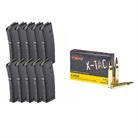
|
X-Tac 5.56 Nato 62gr Penetrator Fmj 1000rd Case With 10x Pmags – 1000rd X-Tac 5.56 Nato 62gr Fmj With 10x 30-Round Pmags |
Brownells.com |
$ 624.99 |
|
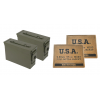
|
Winchester 5.56 NATO Service Grade 55 Grain M193 FMJ Ammunition + Ammo Can |
Bereli |
$ 475.00 |
|
3. $2 Billion for Ammo Materials
“(40) $2,000,000,000 for additional activities to improve the United States stockpile of critical minerals through the National Defense Stockpile Transaction Fund, authorized by subchapter III of chapter 5 of title 50, United States Code;” (page 111 of the pdf.)
What It Means: Ammo needs stuff like copper for bullet jackets, lead for cores, and antimony to make them tough. This $2 billion boosts the National Defense Stockpile to keep these materials ready. It cuts reliance on foreign countries (like China for antimony), avoiding shortages that raise prices.
Why It Matters: With steady materials, factories like Lake City, Winchester, or Sig Sauer can keep making ammo without delays. This supports the $100 million and $1 billion parts by giving them what they need to produce more. It means more ammo in stores and lower prices!
4. $10 Million for More Ammo Workers
“(41) $10,000,000 for the expansion of the Department of Defense armaments cooperation workforce;” (page 111 of the pdf.)
What It Means: This $10 million hires more people, and likely ones to manage ammo production, like planners and quality checkers. They’ll keep places like Lake City running smoothly and make sure the other parts ($100 million, $1 billion, $2 billion) work well.
Why It Matters: More workers mean fewer delays at ammo plants, so more rounds get made. It’s a small piece, but it helps the bigger parts deliver. If Lake City can make an extra million rounds a day, that’s more for our rifles.
How This Could Change Ammo Prices
The OBBB hasn’t affected prices yet—data from WikiArms shows .223/5.56 at ~$0.36/round for bulk buys or ~$0.40/round on average across listings. But based on supply and demand, here’s what could happen when these parts start working.
*NOTE: that price drops depend on military demand and political factors, while increased supply could lower prices to $0.30–$0.35/round, high military needs or new restrictions might limit commercial availability, keeping prices closer to the current $0.36–$0.40/round range.
Live Inventory Price Checker
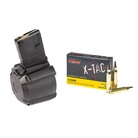
|
X-Tac 5.56 Nato 62gr Penetrator Fmj 1000rd Case With D60 – 1000rd X-Tac 5.56 Nato 62gr Penetrator Fmj With D60 |
Brownells.com |
$ 629.99 |
|
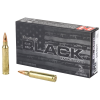
|
Hornady Black 5.56 NATO Ammo 62gr FMJ 20 Rounds |
GunMag Warehouse |
$ 14.49 |
|
|
|
Hornady Frontier 5.56 NATO Ammo 55 Grain FMJ, 20rds – FR200 |
Palmetto State Armory |
$ 11.99 $ 10.79 |
|

|
Winchester 5.56 NATO Service Grade 55 Grain M193 FMJ Ammunition + Ammo Can |
Bereli |
$ 475.00 |
|
Short-Term (2025–2026): The $100 Million Boost
The $100 million for small and medium ammo is the fastest to help. Lake City, making ~4 million rounds daily, could use this to add equipment or workers, possibly adding 50–100 million rounds to stores each year. With more supply, prices could drop to $0.30–$0.35/round for bulk 223/5.56 FMJ. You might see 1000 rounds of 5.56 M193 for $300–$330, down from $360–$400 now.
Long-Term (2027+): New Factories and Materials
The $1 billion for high-tech factories and $2 billion for materials are bigger but slower. New factories could make billions more rounds a year. If half go to civilians, like Lake City’s model, hundreds of millions of rounds could hit stores. With steady materials, prices might fall to $0.25–$0.30/round for 5.56 NATO by 2030. The $10 million for workers keeps these projects on track.
Things to Watch
- Military Needs: The OBBB focuses on military readiness. If wars heat up, the military might take most of the ammo, leaving less for us and keeping prices high.
- Politics: Some have criticized Lake City’s civilian sales because of mass shootings. The OBBB allows these sales, but new laws could limit them, cutting supply.
- Timing: Factories and material stockpiles take years. The $100 million will help soonest, but bigger changes might wait until 2027 or later.

Why This Could Be a Golden Age
Ammo shortages and high prices have been a pain in the wallet. The OBBB could fix that. The $100 million for production can fill shelves fast, while the $1 billion and $2 billion in infrastructure and materials could set up a future where ammo is everywhere. The $10 million workforce keeps it all smooth. Together, they could make this a golden age for small arms ammo—when range days are cheap and we can stock up without going broke.
Imagine walking into a gun shop in 2027 and seeing a stack of Lake City M855 for $250 per 1000 rounds. Weekend shoots with friends won’t hurt your wallet. That’s what the OBBB could do. While all the talk is about military funding, it could trickle down, making shooting easier and cheaper for everyone.
The Bottom Line
The OBBB’s ammo parts—$100 million for production, $1 billion for factories, $2 billion for materials, and $10 million for workers—are a big deal for gun owners. They’ll boost supply at places like Lake City and others, likely dropping prices and making ammo easy to find. Prices haven’t changed yet in July 2025, but a future with cheap 5.56 is coming. Keep checking AmmoLand News for deals, grab ammo when it’s cheap, and get ready for a golden age of shooting. The OBBB might be the best thing for our range bags in years.
What do you think? Do we have it wrong? Excited for cheaper ammo? Share your thoughts, and let’s talk about where you think ammo prices are headed!
Reconciliation Bill Passes Making Tax Stamps for SBRs, SBS, & Suppressors $0
China’s New Export Restriction Choke Hold on Critical U.S. Ammunition Components, Are You Prepared?
AmmoLand Shooting Sports News